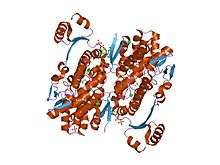HD domain
| HD domain | |||||||||
|---|---|---|---|---|---|---|---|---|---|
 crystal structure of o67745, a hypothetical protein from aquifex aeolicus at 2.0 a resolution. | |||||||||
| Identifiers | |||||||||
| Symbol | HD | ||||||||
| Pfam | PF01966 | ||||||||
| Pfam clan | CL0237 | ||||||||
| InterPro | IPR006674 | ||||||||
| PROSITE | PDOC00924 | ||||||||
| SCOP | 1f62 | ||||||||
| SUPERFAMILY | 1f62 | ||||||||
| CDD | cd00077 | ||||||||
| |||||||||
In molecular biology, the HD domain is a conserved protein domain, named after the conserved histidine (H) and/or aspartate (D) amino acid residues. It is found in a superfamily of enzymes with a predicted or known phosphohydrolase activity. These enzymes appear to be involved in nucleic acid metabolism, signal transduction and possibly other functions in bacteria, archaea and eukaryotes. The fact that all the highly conserved residues in the HD superfamily are histidines or aspartates suggests that coordination of divalent cations is essential for the activity of these proteins.[1]
References
- ↑ Aravind L, Koonin EV (December 1998). "The HD domain defines a new superfamily of metal-dependent phosphohydrolases". Trends in Biochemical Sciences. 23 (12): 469–72. doi:10.1016/s0968-0004(98)01293-6. PMID 9868367.
This article is issued from
Wikipedia.
The text is licensed under Creative Commons - Attribution - Sharealike.
Additional terms may apply for the media files.